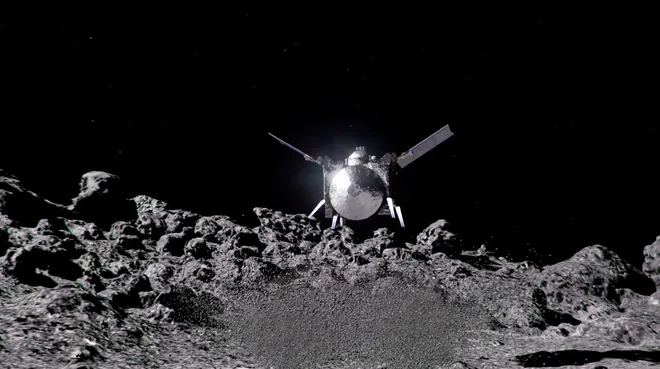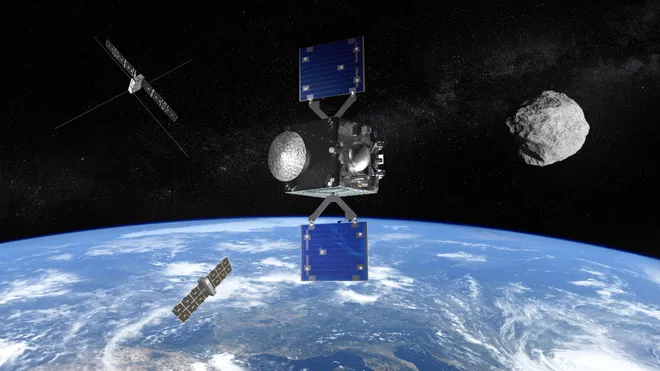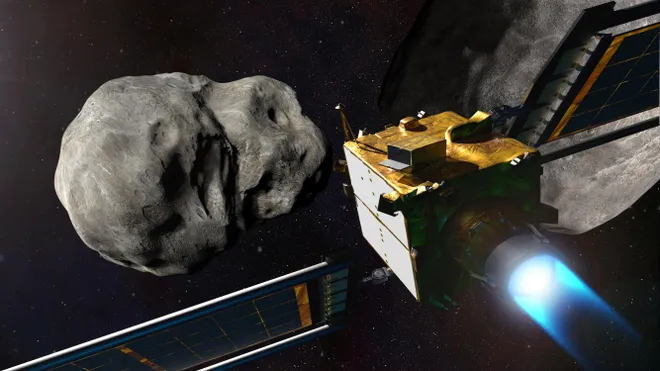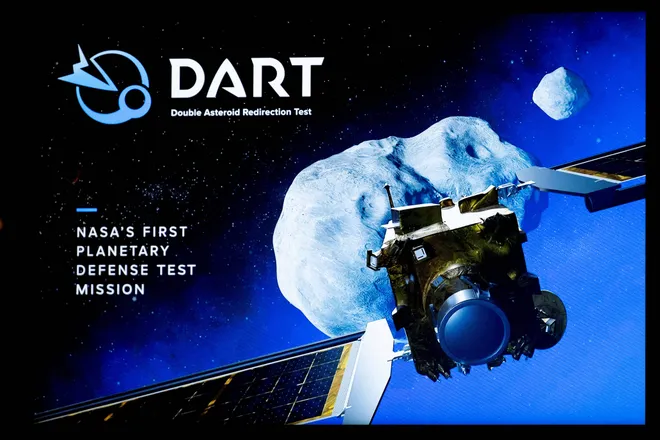Asteroids safely fly by Earth all the time. Here’s why scientists are watching Apophis.
- Apophis is projected to pass within 20,000 miles of our planet’s surface on April 13 2029. The menacing asteroid will harmlessly pass by, astronomers say.
- Apophis measures nearly a quarter of a mile long – about the size of a cruise ship – making it large enough to be visible to the naked eye when it shoots past Earth.
- Space agencies and scientific institutes around the world are planning to use the rare flyby to explore Apophis from the ground with telescopes and even spacecraft.
Among astronomers both professional and amateur, perhaps no asteroid is more notorious than Apophis.
If you've heard of Apophis, then you're likely aware of the reputation it gained upon its discovery two decades ago as a potentially very dangerous space rock hurtling too close for comfort toward Earth. It was initially believed that the asteroid could one day pose a serious threat to our planet.
And one day, it just might.
But that day won't come for at least 100 years, astronomers say. No, not even in 2029, when Apophis makes the closest approach to Earth that any asteroid of its size ever has – at least, one that scientists have known about in advance.
Additional observations of Apophis have allowed astronomers to long rule out the risk of an impact in 2029 when Apophis is predicted to come within a distance of Earth 10 times closer than the moon, according to NASA. The asteroid also won't hit our planet when it makes another close approach in 2036.
While we and our children are safe from Apophis' wrath, scientists still see a valuable opportunity to study the asteroid as it whizzes by Earth to learn what they can of other space rocks that actually could hit our planet.
Here's what to know about Apophis and how space agencies hope to protect Earth from other asteroids like it.
Apophis to make 2029 flyby to Earth
Apophis is projected to pass within 20,000 miles of our planet’s surface on April 13, 2029.
For the superstitious lot, yes, that's a Friday, no less.
On that day, Apophis will come closer than telecommunications satellites in geostationary orbit, the ESA says.
The close encounter with Earth will make the asteroid visible in the Eastern hemisphere, including in Europe, Africa, and western Asia. It should look somewhat like a bright star streaking across the sky.
Earth's gravity will significantly influence Apophis – squeezing and distorting the asteroid as one side is pulled toward our planet more than the other. While no affects will be felt on Earth, Apophis may experience some quakes and even landslides, the ESA said.
Will Apophis hit earth?
In short, no. Not during our lifetimes, anyway.
While Apophis is classified as a near-Earth asteroid because its orbit bring it within 30 million miles of Earth, you have nothing to fear from it.
Apophis was initially identified as one of the most hazardous asteroids that could impact Earth after its 2004 discovery, but that assessment has since changed as astronomers tracked it and learned more about its orbit.
While the risk of it impacting Earth during its 2029 flyby rose as high as 2.7%, Apophis has since been removed from NASA’s Sentry Impact Risk Table. That's thanks to a radar observation campaign in March 2021 during a distant flyby that – combined with precise orbit analysis – allowed astronomers to determine that the asteroid poses no risk of crashing into Earth for at least a century.
How big is the Apophis asteroid?
Apophis measures nearly a quarter of a mile long – about the size of a cruise ship – making it large enough to be visible to the naked eye when it shoots past Earth.
The Planetary Society compares its size to the equivalent of about five football fields and taller than the Empire State Building in New York City.
It's hard to know just exactly what Apophis looks like, as scientists do not yet have images of it. But radar observations have suggested that Apophis is shaped roughly like a peanut – a relatively common shape among near-Earth asteroids larger than 660 feet in diameter, according to NASA.
Apophis is believed to be stony, made up of silicate (or rocky) materials and a mixture of metallic nickel and iron.
What would happen if Apophis hit Earth?
Though not as big or catastrophic as the asteroid theorized to have wiped out the dinosaurs 66 million years ago, Apophis would cause widespread destruction up to several hundred kilometers from its impact site.
The energy released would be equal more than 1,000 megatons of TNT, or tens to hundreds of nuclear weapons, according to the Planetary Society, a nonprofit organization promoting space exploration.

What does 'Apophis' mean?
Apophis is no different from other asteroids in that it is a remnant from the early formation of our solar system about 4.6 billion years ago. It originated in the main asteroid belt between Mars and Jupiter and spent millions of years being altered by the gravitational influence of large planets such as Jupiter, NASA said.
Now, Apophis's orbit around the sun brings it startlingly close to Earth.
It's partly due to its proximity, as well as the sheer devastation its impact with Earth would bring, that astronomers named the asteroid after an ancient Egyptian god of disorder.
Specifically, Apophis is named for the demon serpent who personified evil and chaos.
ESA, NASA hope to study Apophis

Space agencies and scientific institutes around the world are planning to use the rare flyby to explore Apophis from the ground with telescopes and even spacecraft.
NASA's OSIRIS-REx, which gathered and returned a sample of asteroid Bennu in September, has been renamed OSIRIS-APophis EXplorer (OSIRIS-APEX) and sent on a trajectory that would allow it to cross paths with the asteroid in 2029. When it has its rendezvous with Apophis in June that year, OSIRIS-APEX will spend 18 months mapping the asteroid’s surface and analyzing its chemical makeup, according to NASA.
Earth-based telescopes will observe Apophis as well, but they won't be able to detect as much as the spacecraft will when the asteroid gets near the sun, NASA said. But unlike with the Bennu mission, OSIRIS-APEX will not collect a sample from Apophis.
The European Space Agency, NASA's counterpart across the pond, plans to launch a spacecraft of its own called Ramses.

The Ramses spacecraft, which must be ready to launch a year ahead of time, will meet Apophis before it passes by Earth and accompany it on its way out of our orbit. During that time, the mission will observe how the surface of the asteroid changes from being in such close proximity to Earth, the European Space Agency said in July.
NASA takes on dangerous asteroids
The expedition is all part of the steps NASA and other space agencies have taken in recent years to protect humanity from threats posed by asteroids and other inbound space rocks, such as comets.

In September 2022, NASA intentionally slammed a spacecraft into the small asteroid Dimorphos at roughly 14,000 mph.
Though Dimorphos posed no threat to Earth, the mission served as the first demonstration of NASA's Double Asteroid Redirection Test, or DART. If an incoming asteroid is ever on a collision course with our planet, the space agency has said that the DART method could prove crucial for deflecting and changing the object's orbital path.

And to gauge whether authorities are prepared to defend Earth from space objects, NASA has hosted a series of exercises, the fifth and most recent of which occurred in April, with findings announced in June. It was the first such exercise to include about 100 international government representatives who gathered to work through a hypothetical scenario about an inbound asteroid.
The exercise was organized by the U.S. space agency's Planetary Defense Coordination Office, which was established in 2016 to catalog near-Earth objects that could crash into the planet.
NASA is also working on an asteroid-hunting telescope known as the NEO Surveyor to find near-Earth objects capable of causing significant damage. Set to launch no earlier than June 2028, the telescope is designed to discover 90% of asteroids and comets that are 460 feet in size or larger and come within 30 million miles of Earth’s orbit.
Contributing: Claire Thornton, USA TODAY
Eric Lagatta covers breaking and trending news for USA TODAY. Reach him at elagatta@gannett.com
Disclaimer: The copyright of this article belongs to the original author. Reposting this article is solely for the purpose of information dissemination and does not constitute any investment advice. If there is any infringement, please contact us immediately. We will make corrections or deletions as necessary. Thank you.



